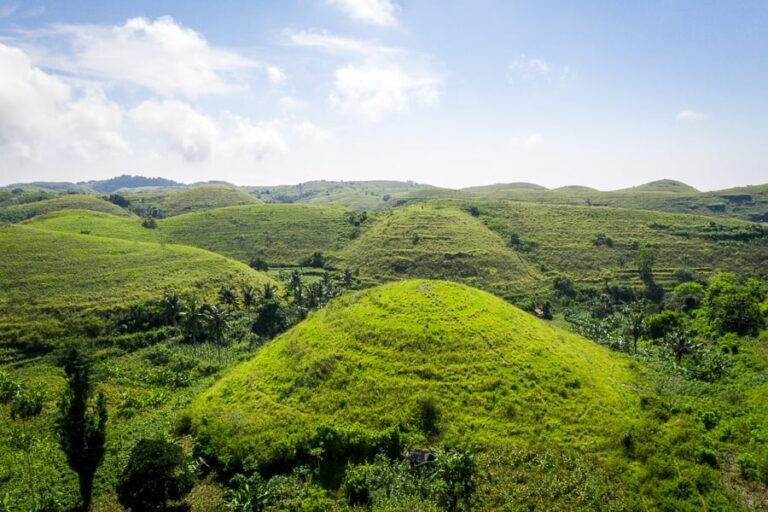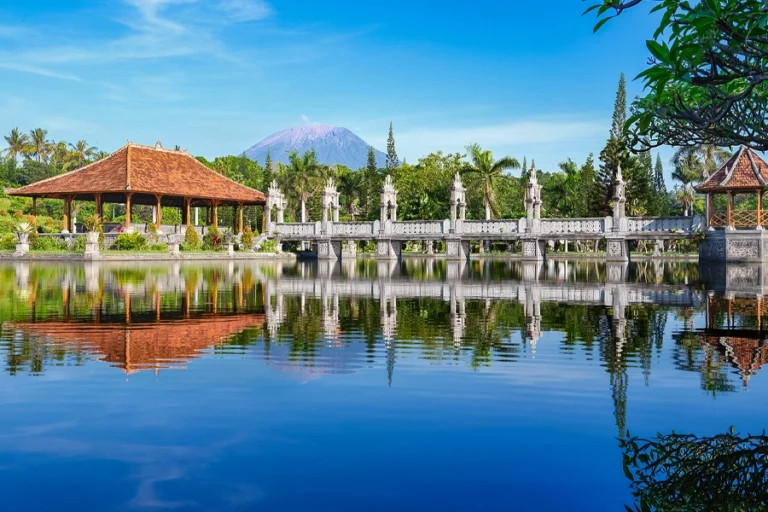Jatiluwih Rice Terraces are a must-see destination in Bali, offering a perfect blend of breathtaking natural beauty and deep cultural heritage. Nestled in the heart of Tabanan Regency, this UNESCO World Heritage site highlights the profound connection between the Balinese people and their land. More than just a scenic view, Jatiluwih embodies centuries of agricultural tradition, where harmony between humanity and nature unfolds with every step you take.

Imagine standing amidst endless waves of vivid green, with tiered rice paddies flowing down the hills like steps to the sky. The air is crisp and clean, the surroundings peaceful, and the only sounds are the gentle rustling of rice leaves and distant birdsong. In Jatiluwih, time slows down, inviting you to soak in the serenity and heritage of this extraordinary landscape.
This guide will equip you with everything you need to plan your visit—from practical tips like entrance fees and how to get there, to insights into the site’s historical significance. Whether you’re in search of peaceful exploration, cultural connection, or natural wonder, Jatiluwih Rice Terraces offer an unforgettable journey into the heart of Bali.
Entrance Fees
Planning your visit to Jatiluwih Rice Terraces? Understanding the entrance fees will help you prepare. As of January 2025, international visitors are required to pay IDR 50,000 (approximately USD 3.30). For children aged 12 and under, the fee is IDR 20,000 (around USD 1.30), while kids under 5 can enter for free—making Jatiluwih a budget-friendly destination for families.
More than just an entry ticket, your fee supports the preservation of Jatiluwih’s cultural and agricultural heritage. It helps maintain the ancient subak irrigation system, a community-based water management practice that has sustained the rice terraces for generations. By visiting, you’re not only enjoying the landscape—you’re also helping the local farmers keep this living tradition thriving for the future.

Getting to Jatiluwih Rice Terraces
Reaching the stunning Jatiluwih Rice Terraces is an adventure all its own. From Ubud, the scenic drive takes approximately 1.5 hours, winding through lush landscapes and traditional Balinese villages. If you’re coming from Denpasar or Kuta, expect a journey of around 2 hours, depending on traffic. There are several convenient ways to get there:
By Car or Motorbike
Renting a car or motorbike gives you the freedom to explore at your own pace. The roads leading to Jatiluwih are generally well-marked but can be narrow and winding, so confident driving is recommended. Along the way, you’ll pass through charming villages and scenic viewpoints that reveal Bali’s untouched countryside.
By Taxi or Private Driver
If you prefer a more relaxed experience, hiring a private driver is an excellent choice. Many drivers also serve as informal guides, sharing local insights and pointing out hidden gems during the ride. Full-day hires typically cost between IDR 500,000 and 800,000, depending on your location and trip duration.
Guided Tours for a Richer Experience
To truly make the most of your visit, consider joining a guided tour, such as those offered by Foki Bali Tours. These tours provide a well-rounded experience, blending cultural knowledge with the natural beauty of the terraces.
Address & Accessibility
Tucked away in the serene highlands of Tabanan Regency, the Jatiluwih Rice Terraces offer a peaceful escape far from Bali’s busier tourist hubs. You’ll find them in Jatiluwih Village, Penebel, Tabanan Regency, Bali—a location that adds to their tranquil, untouched charm.
The drive from Ubud or South Bali takes about 1.5 to 2 hours, depending on traffic. While the roads are generally well-maintained, be prepared for some winding mountain stretches as you approach the village.
Upon arrival, you’ll find ample parking available, and the terraces themselves are easily explored on foot. Clearly marked walking paths guide you through the vibrant, terraced fields, offering spectacular views and peaceful moments at every turn.
Best Times to Visit Jatiluwih
For the most enchanting experience, visit the Jatiluwih Rice Terraces in the early morning or late afternoon, when the sunlight casts a golden glow over the landscape and the air is refreshingly cool. These times of day not only offer ideal lighting for photography but also give you the chance to observe local farmers at work—continuing traditions passed down through generations.
To catch the terraces at their greenest and most photogenic, plan your trip during the growing season, which typically peaks from March to September. During these months, the paddies are lush and vibrant, turning the hills into a living canvas of layered greenery.
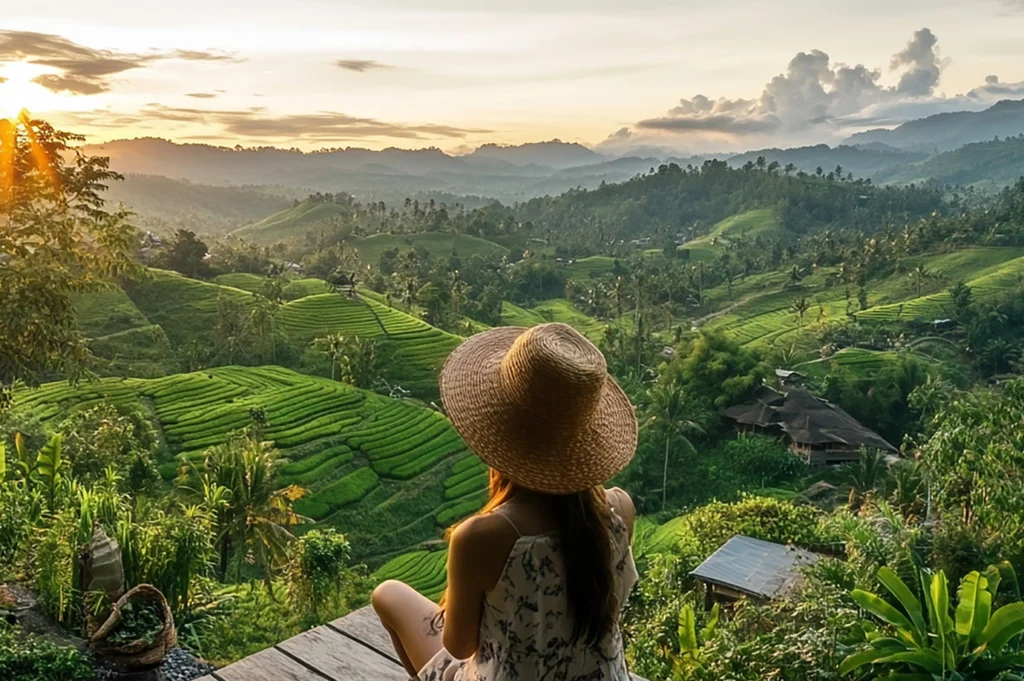
What To See & Do
Jatiluwih isn’t just a place to admire—it’s a destination where you can truly immerse yourself in Bali’s natural beauty and cultural heritage. Here are some of the best ways to experience all it has to offer:
Trekking
Wander through the rice terraces on foot along clearly marked trails that guide you deep into the heart of Jatiluwih. Along the way, you’ll pass by traditional huts, cross gentle streams, and witness local farmers tending to their fields. It’s the most intimate way to connect with the land and gain a closer look at the ancient subak irrigation system in action.
Cycling
Prefer a more active adventure? Cycling through Jatiluwih offers a thrilling way to explore the area. With routes ranging from gentle to challenging, it’s perfect for both beginners and experienced riders. As you pedal along winding paths, you’ll uncover hidden corners of the terraces that many visitors overlook.
Photography
For shutterbugs, Jatiluwih is a dream come true. The terraced landscape provides endless photography opportunities, especially during the golden hours of early morning or late afternoon. Capture sweeping vistas, the rhythmic lines of the rice fields, and the authentic essence of rural Balinese life.

Myths and Legends
Jatiluwih is not only a place of scenic wonder—it’s also a landscape shaped by legend and spiritual belief. Local folklore weaves a mystical thread through the green terraces, adding depth and meaning to their natural beauty.
One enduring tale speaks of a sacred serpent believed to dwell in the mountains above Jatiluwih. According to legend, this mystical creature controls the water flow that nourishes the rice fields. Farmers make ceremonial offerings to the serpent during key rituals, hoping to ensure a fertile harvest and continued harmony with nature.
Another story centers around Batara Wisnu, the Balinese god of agriculture. Locals believe that Wisnu blessed the region with abundant fertility and continues to watch over the fields and the people who tend them. His spiritual presence is said to protect the land, reinforcing the deep reverence Balinese culture holds for its environment.
These legends are more than just tales—they represent a spiritual bond between the land, the people, and the divine, reinforcing Jatiluwih’s role not only as a place of beauty, but also as a sacred space.
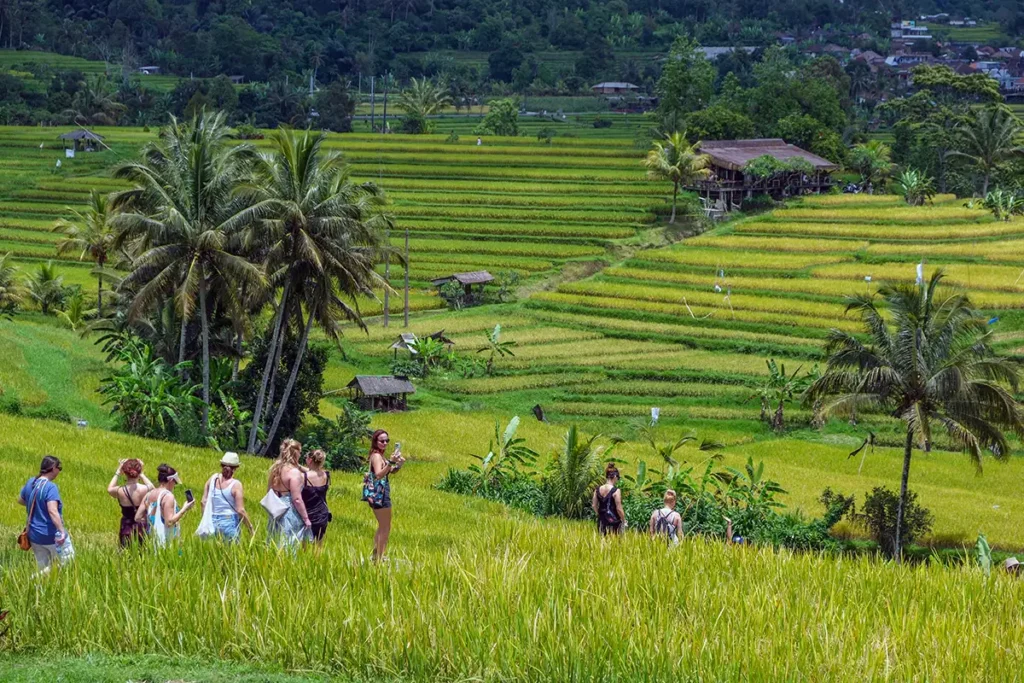
Historical Background
The history of the Jatiluwih Rice Terraces is as rich and layered as the landscape itself. With roots tracing back to the 9th century, this region has been shaped by over a thousand years of continuous rice cultivation—making it one of the oldest and most culturally significant agricultural sites in Bali.
At the heart of this enduring legacy is the subak system, a community-based method of water management. More than just an irrigation network, subak is a living expression of Tri Hita Karana—the Balinese philosophy that promotes harmony between humans, nature, and the divine. Through the cooperative efforts of local farmers, water is distributed fairly and sustainably, ensuring that the terraces thrive season after season.
To walk through Jatiluwih is to step into living history. The methods used today mirror those practiced centuries ago, offering a glimpse into a resilient agricultural tradition that has withstood time and change. The rice terraces stand as a testament to Balinese ingenuity, cultural identity, and an unwavering connection to the land.

Significance
The Jatiluwih Rice Terraces are far more than a scenic destination—they are a powerful symbol of Bali’s cultural soul and agricultural brilliance. Recognized as a UNESCO World Heritage Site, Jatiluwih stands as a shining example of a living cultural landscape, where human life and the natural world exist in thoughtful balance.
These terraces reflect the ingenuity, resilience, and unity of the Balinese people, who have cultivated rice on this challenging terrain for centuries. At the heart of this success lies the subak system—a communal, centuries-old method of water management that represents not only an engineering triumph but also a model of social harmony and sustainability.
Yet Jatiluwih’s true beauty goes beyond agriculture. It’s a place where spiritual values and daily life intertwine, where farming is seen not just as labor, but as a sacred duty to the earth and the gods. This unique blend of practicality, spirituality, and tradition is what makes Jatiluwih a place of profound significance—and why it continues to captivate and inspire all who visit.
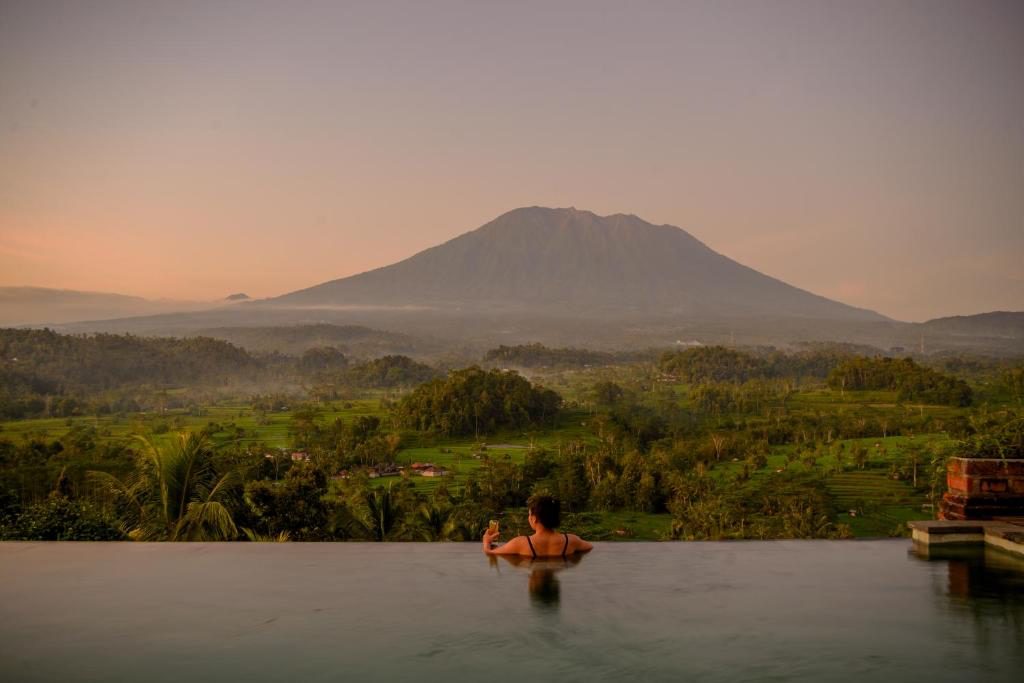
Jatiluwih Nearby Hotels
To truly absorb the calm and beauty of Jatiluwih, consider spending the night in one of the nearby accommodations. Staying overnight allows you to experience the magical quiet of the terraces at dawn and dusk—moments many day-trippers miss.
Sang Giri Mountain Glamping
For a unique stay, Sang Giri Mountain Glamping offers an unforgettable blend of nature and comfort. Enjoy the luxury of fully equipped tents with breathtaking views of the mountains and rice terraces. It’s an ideal base for travelers seeking both adventure and tranquility, surrounded by lush jungle and fresh mountain air.
Prana Dewi Mountain Resort
If you’re looking for peace and rejuvenation, Prana Dewi Mountain Resort is the perfect escape. Nestled among gardens and rice fields, this retreat features traditional Balinese bungalows and offers yoga, meditation, and guided nature treks. It’s a serene sanctuary for anyone looking to reconnect with themselves and the natural world.
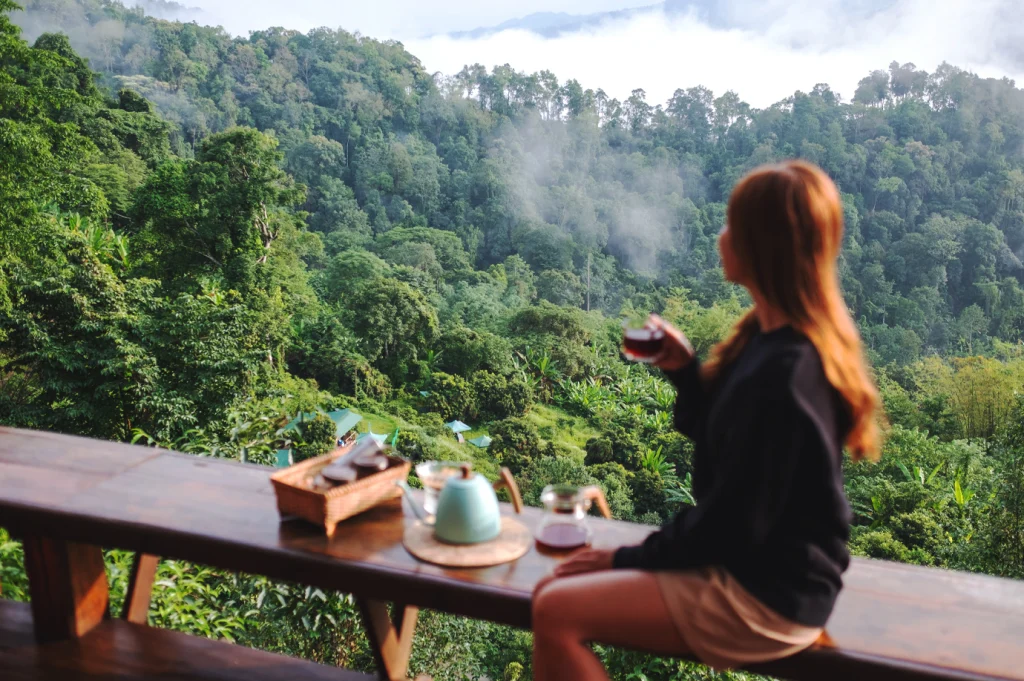
Nearby Restaurants
After soaking in the breathtaking beauty of Jatiluwih, chances are you’ll have worked up quite an appetite. Fortunately, the area offers several charming dining spots where you can relax and refuel—all while continuing to enjoy the stunning surroundings.
Jatiluwih Green Warung
Located conveniently at the entrance to the terraces, Jatiluwih Green Warung serves up a mouthwatering selection of traditional Balinese dishes made from fresh, local ingredients. With its open-air seating and sweeping views of the rice fields, it’s the perfect place to unwind and enjoy a flavorful, post-trek meal.
Billy’s Terrace Café
Perched on a hillside, Billy’s Terrace Café offers panoramic views of the surrounding landscape. The menu is a delicious blend of Balinese and Western favorites—from savory Nasi Campur to hearty burgers. Whether you’re stopping for lunch or just a cold drink, this café delivers both taste and scenery in equal measure.
Warung Dhea
For a more intimate and authentic experience, Warung Dhea is a must-visit. This small, family-run spot specializes in home-cooked Balinese meals, lovingly prepared with ingredients sourced from nearby farms. The cozy setting and genuine hospitality make it feel like dining with old friends.
These aren’t just places to eat—they’re part of the Jatiluwih experience. Each bite connects you more deeply to the land, the people, and the timeless rhythm of Bali’s countryside.
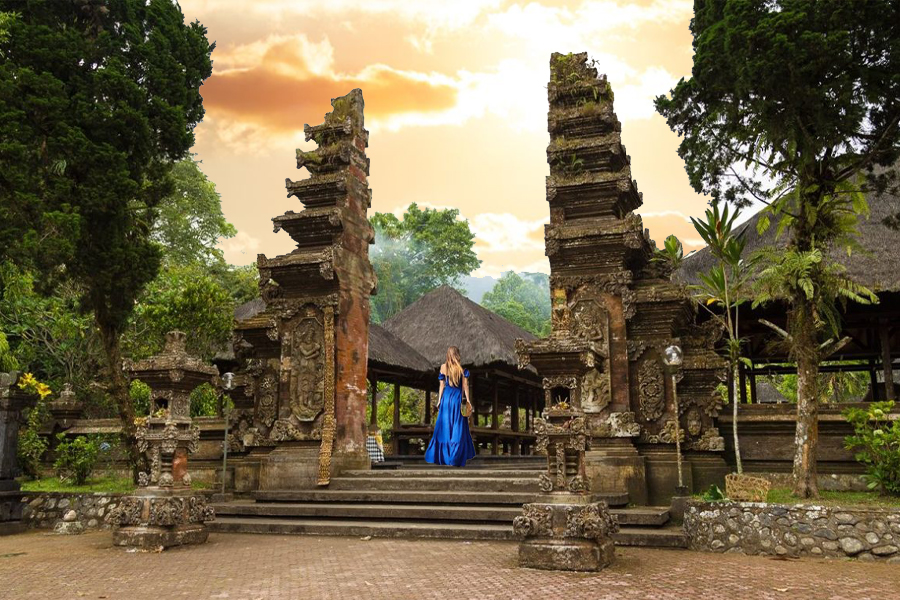
Nearby Attractions to Jatiluwih
While the Jatiluwih Rice Terraces are undoubtedly the crown jewel, the surrounding region is brimming with natural beauty and cultural treasures waiting to be explored. Extend your journey beyond the terraces and uncover these remarkable nearby gems:
Batukaru Temple
Just a scenic 53-minute drive (13.3 miles) from Jatiluwih lies the serene Batukaru Temple, nestled in the lush rainforest along the slopes of Mount Batukaru. One of Bali’s most sacred sites, this ancient Hindu temple radiates tranquility and spiritual depth. Stroll through moss-covered courtyards, marvel at the intricate stone carvings, and soak in the peaceful ambiance that defines this mystical sanctuary.
Taman Ayun Temple
Approximately 45 minutes (12.4 miles) from Jatiluwih, Taman Ayun Temple—the Royal Water Temple—welcomes visitors with its beautiful moats, tiered shrines, and immaculately landscaped gardens. A legacy of the Mengwi Kingdom, this temple is a perfect example of Bali’s balance between architecture, spirituality, and nature. Its tranquil setting makes it an ideal stop for reflection and admiration.
Tanah Lot Temple
About 55 minutes (13.4 miles) away from Jatiluwih, you’ll find the iconic Tanah Lot Temple, dramatically perched on a rock formation amidst the sea. As waves crash against the base and the sun sets on the horizon, this sea temple transforms into one of Bali’s most magical sights. A spiritual stronghold with jaw-dropping views, it perfectly captures Bali’s deep reverence for both the ocean and the divine.
These nearby landmarks offer a deeper dive into Bali’s rich cultural and spiritual landscape. Each one invites you to explore, reflect, and connect more deeply with the island’s timeless beauty and heritage—adding layers of meaning to your Jatiluwih journey.
Travel Tips
Planning your first trip to the Jatiluwih Rice Terraces? With a little preparation, your visit can be smooth, meaningful, and truly unforgettable. Here are some helpful tips to ensure you make the most of your experience:
Dress Appropriately
The walking trails through the terraces can be narrow, uneven, and at times quite steep. Wear comfortable shoes with good grip, and opt for light, breathable clothing to stay cool in Bali’s warm and humid climate.
Stay Hydrated
The sun can be intense—especially during the dry season. Bring a reusable water bottle, wear sunscreen, and don’t forget a hat or sunglasses to protect yourself while exploring under the tropical sun.
Respect the Local Culture
Jatiluwih is more than just a beautiful view—it’s an active farming community and a site of cultural significance. Stay on the paths, avoid stepping on the rice plants, and show respect to the farmers you encounter.
Carry Cash
Although the main entrance may accept cards, local vendors along the way often don’t. Having cash on hand makes it easy to buy snacks, refreshments, or unique handmade souvenirs—and even tip local guides or farmers if you’d like.
Visit Early
For a peaceful experience, aim to arrive early in the morning. You’ll beat the crowds, enjoy the best lighting for photography, and benefit from the cooler morning temperatures.
Take Your Time
Jatiluwih is a place meant to be savored, not rushed. Walk slowly, breathe deeply, and take in the soothing atmosphere and scenic views. It’s the perfect place to unplug and reconnect with nature.
By keeping these tips in mind, you’ll not only enhance your own experience, but also help preserve the beauty and culture of Jatiluwih for future visitors.


